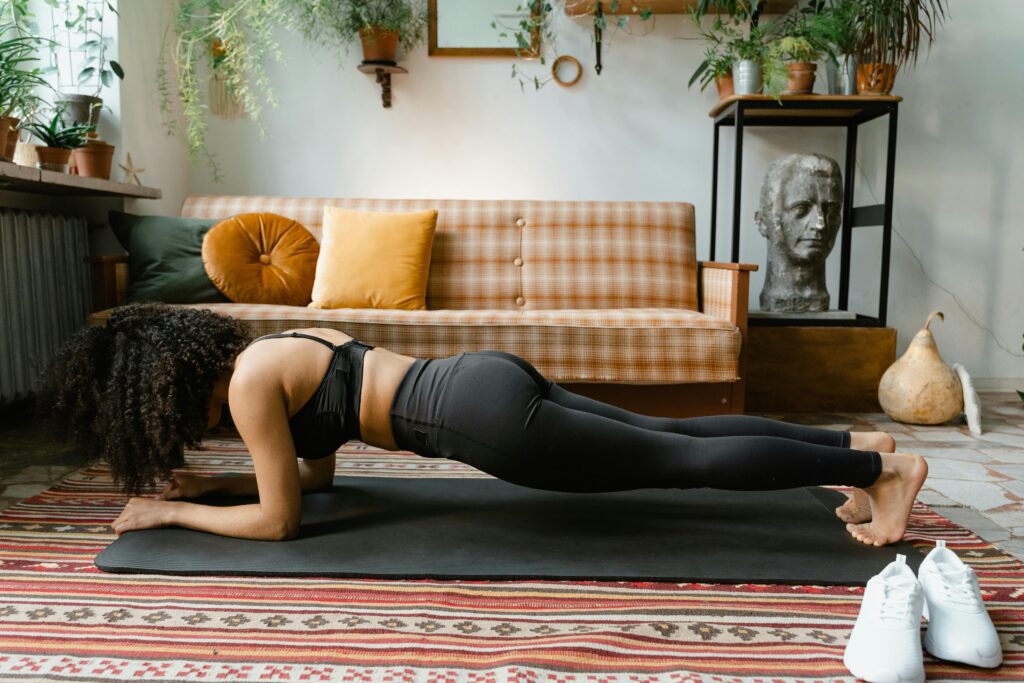In today’s fast-paced world, finding time for a workout can be challenging. Whether you’re traveling, stuck at home, or simply short on time, full-body exercises offer a convenient way to stay fit without needing a gym or fancy equipment. These exercises not only provide a comprehensive workout but also cater to busy schedules, making them perfect for anyone looking to stay active on the go.
Full-body workouts are a boon for those with packed schedules or frequent travelers. They offer the flexibility to exercise anytime, anywhere, ensuring you can maintain your fitness regimen without relying on gym access or specialized equipment. Let’s explore five effective exercises that target multiple muscle groups and can be seamlessly integrated into your daily routine.
Exercise 1: Bodyweight Squats
Bodyweight squats represent a foundational exercise in fitness, offering a straightforward yet effective method to enhance muscle strength and overall physical fitness. This exercise requires no equipment, making it accessible for anyone looking to improve their lower body strength and functional mobility. By mastering proper form and technique, bodyweight squats can be integrated seamlessly into daily workouts, providing benefits that extend beyond muscle development to include improved posture, core stability, and enhanced daily movement capabilities.

Instructions:
- Stand with your feet shoulder-width apart.
- Lower your body by bending your knees and pushing your hips back as if you’re sitting down on a chair.
- Keep your chest upright and your knees behind your toes.
- Push through your heels to return to the starting position.
- Repeat for a set of 10-15 repetitions.
Variations:
- Pulse Squats: Perform a small pulsing motion at the bottom of the squat to increase time under tension.
- Jump Squats: Add a jump as you return to the starting position to increase intensity.
Common Mistakes to Avoid:
- Allowing your knees to collapse inward.
- Leaning too far forward, which puts strain on your lower back.
- Not squatting low enough (thighs parallel to the ground) to engage muscles fully.
Benefits:
- Strengthens leg muscles (quadriceps, hamstrings, calves).
- Improves core stability and balance.
- Ideal for beginners; enhances overall lower body strength.
Exercise 2: Push-Ups

Push-ups are a classic exercise known for their ability to build strength in the upper body and core muscles. This fundamental bodyweight exercise requires no equipment and can be performed virtually anywhere, making it a versatile addition to any fitness routine. By mastering the correct technique and incorporating variations suited to your fitness level, push-ups not only enhance muscular endurance and strength but also contribute to improved posture and overall physical fitness.
Instructions:
- Start in a plank position with your hands shoulder-width apart and arms straight.
- Lower your body by bending your elbows until your chest nearly touches the floor.
- Keep your body straight from head to heels.
- Push through your palms to straighten your arms and return to the starting position.
- Perform as many repetitions as you can, aiming for 8-12.
Variations:
- Knee Push-Ups: Perform push-ups with your knees on the ground for less intensity.
- Decline Push-Ups: Elevate your feet on a step or bench to increase difficulty.
Common Mistakes to Avoid:
- Allowing your lower back to sag.
- Positioning your hands too wide or too narrow.
- Not fully extending your elbows at the top of the movement.
Benefits:
- Builds upper body strength (chest, shoulders, triceps).
- Enhances core stability and improves posture.
Exercise 3: Planks
Planks are renowned for their effectiveness in developing core strength and stability. This foundational bodyweight exercise requires minimal space and equipment, making it accessible for individuals of all fitness levels. By mastering proper form and engaging key muscle groups, planks offer benefits beyond core strengthening, including improved posture, enhanced balance, and increased overall endurance.

Instructions:
- Start in a forearm plank position with elbows directly under shoulders and forearms on the ground.
- Keep your body in a straight line from head to heels, engaging your core muscles.
- Hold the position for 30-60 seconds, or as long as possible, without letting your hips sag or rise.
Common Mistakes to Avoid:
- Dropping your hips too low.
- Rounding or sagging your back.
- Holding your breath.
Benefits:
- Strengthens core muscles (abdominals, obliques, lower back).
- Improves overall stability and posture.
Exercise 4: Jumping Jacks
Jumping jacks are a dynamic exercise that combines cardiovascular conditioning with coordination enhancement. This classic bodyweight movement requires no equipment and can be performed almost anywhere, making it ideal for quick bursts of physical activity. By incorporating jumping jacks into your fitness routine, you can elevate your heart rate, improve cardiovascular health, and enhance coordination skills, all while enjoying a versatile and effective workout.

Instructions:
- Stand with your feet together and arms at your sides.
- Jump while spreading your legs shoulder-width apart and simultaneously raising your arms above your head.
- Jump back to the starting position with feet together and arms at your sides.
- Repeat continuously for 1-2 minutes.
Variations:
- Low Impact Jacks: Perform jumping jacks without the jump to reduce impact.
- Cross Jacks: Cross your arms and legs in front of your body instead of raising them to the sides.
Common Mistakes to Avoid:
- Allowing your knees to collapse inward during the movement.
- Swinging your arms too forcefully, which can strain shoulders.
- Not maintaining a steady pace throughout.
Benefits:
- Boosts cardiovascular fitness.
- Improves coordination and agility.
Exercise 5: Lunges
Lunges are a fundamental lower body exercise known for their ability to target and strengthen various muscle groups, including the quadriceps, hamstrings, glutes, and calves. This bodyweight exercise requires minimal space and no equipment, making it accessible for home workouts or gym sessions. By mastering proper form and incorporating variations suited to your fitness level, lunges not only build muscular strength but also enhance balance, stability, and functional movement patterns essential for daily activities.

Instructions:
- Stand with feet hip-width apart.
- Take a step forward with your right leg, lowering your body until both knees are bent at a 90-degree angle.
- Keep your front knee aligned with your ankle and your back knee pointing toward the floor.
- Push back to the starting position and repeat on the other leg.
- Perform 10-12 repetitions on each leg.
Variations:
- Reverse Lunges: Step backward instead of forward to emphasize different muscle groups.
- Walking Lunges: Perform lunges while walking forward to increase intensity and coordination.
Common Mistakes to Avoid:
- Allowing your front knee to extend beyond your toes.
- Leaning too far forward, which can strain your lower back.
- Not maintaining proper alignment of your back knee with your hips.
Benefits:
- Strengthens leg muscles (quadriceps, hamstrings, glutes).
- Improves balance and flexibility.
Conclusion
Incorporating these exercises into your daily routine can provide a full-body workout without the need for a gym. They target multiple muscle groups, improve strength, enhance flexibility, and boost cardiovascular fitness—all crucial components of a balanced fitness regimen. Start integrating these exercises today to maintain your fitness goals, even when life gets hectic.
Remember, consistency is key to achieving and maintaining fitness. Stay tuned for more workout ideas and motivational tips in upcoming posts, and discover how easy it is to stay active wherever you are. Start now and feel the difference these exercises can make in your overall health and well-being.












